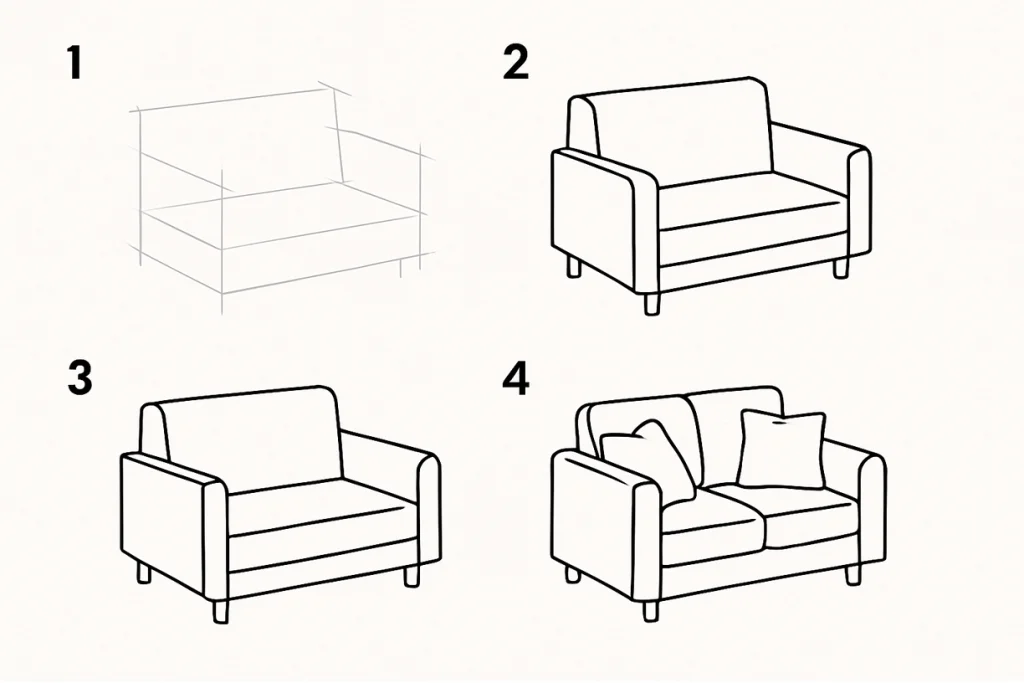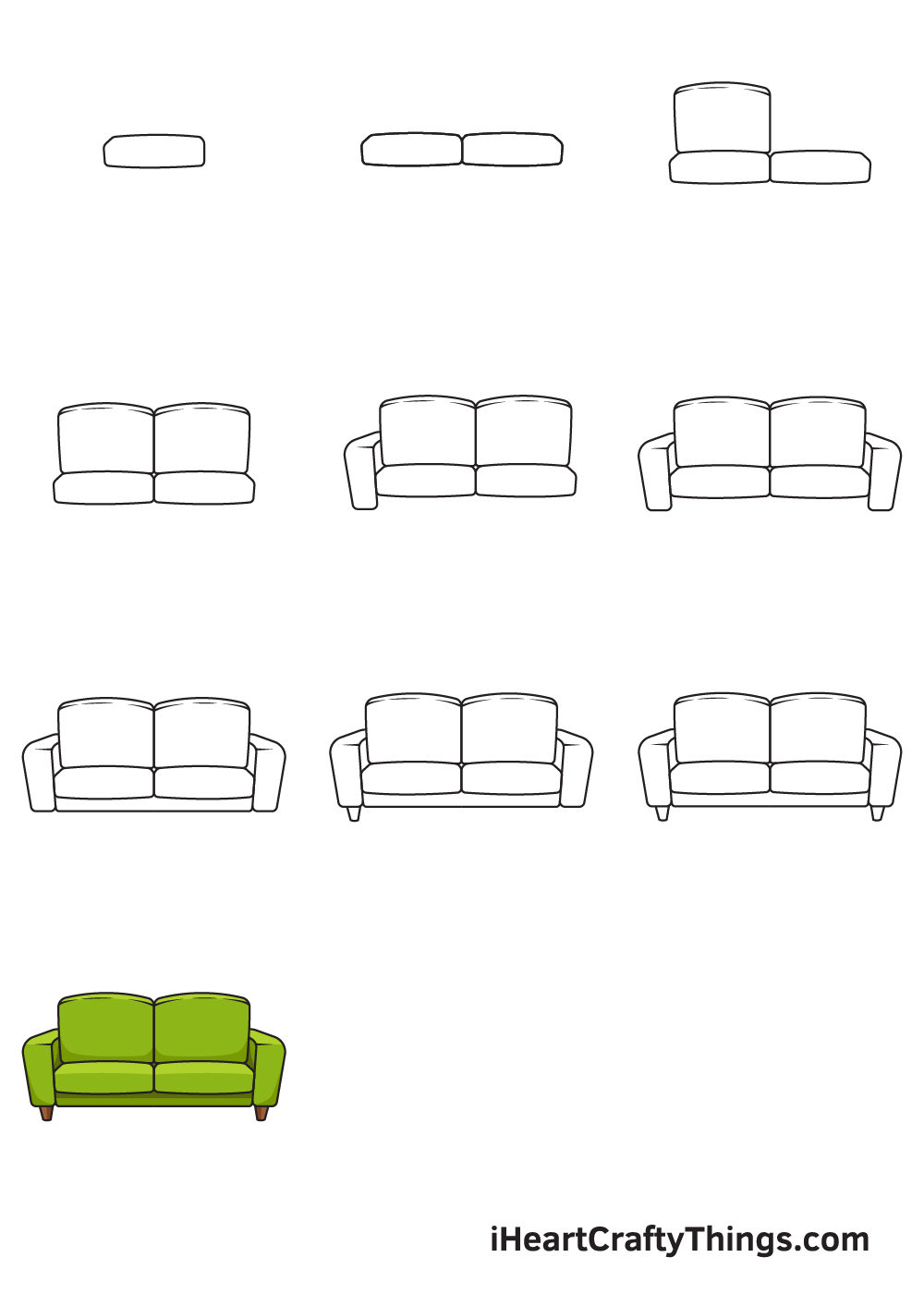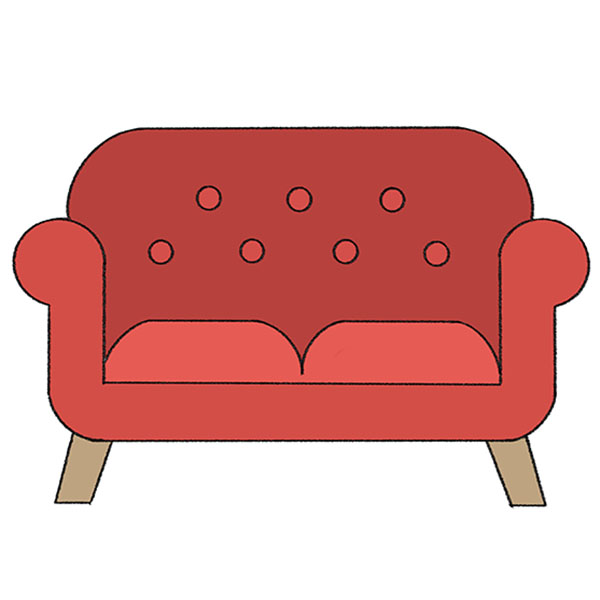Are you ready to unleash your inner artist and create something beautiful? Drawing a sofa might seem daunting at first, but with a few simple steps, you can transform a blank page into a cozy masterpiece.

Imagine being able to capture the essence of comfort and style with just a pencil and paper. Whether you’re a beginner or someone looking to refine your skills, learning how to draw a sofa can be both fun and rewarding.
This guide will walk you through the process, step by step, so you can confidently sketch sofas that look like they belong in a designer showroom. Get ready to impress yourself with what your creativity can achieve!

Credit: iheartcraftythings.com
Contents
Materials Needed
Embarking on the creative journey of drawing a sofa can be both exciting and rewarding. But before you put pencil to paper, it’s crucial to gather the right materials. Having the correct tools not only makes the process smoother but also enhances your final artwork. As someone who once tried sketching with just a dull pencil, I can assure you that the right materials make a significant difference.
1. Pencils
Your choice of pencils can set the tone for your drawing. Opt for a range of pencils, from HB for lighter sketches to 2B or 4B for darker shades. This variety will give you flexibility in shading and detailing.
2. Erasers
Mistakes are part of the learning curve, and a good eraser will be your best friend. Kneaded erasers are great for lightening areas without completely removing them. If precision is key, a pencil eraser can help you tackle those intricate details.
3. Paper
The type of paper you choose can affect the texture and appearance of your sofa drawing. Opt for a smooth sketchbook paper or high-quality drawing paper. These options provide a good balance of texture and durability.
4. Rulers
Accuracy in your drawing is crucial, especially with geometric furniture like sofas. A ruler helps you maintain straight lines and proportions. If your sofa has curves, a flexible ruler can be quite handy.
5. Reference Images
Unless you’re drawing from memory, reference images are vital. They provide guidance on proportions, angles, and details. Collect images of various sofa styles to inspire your creativity and challenge your skills.
Now, with these materials in hand, you’re better equipped to capture the essence of a sofa on paper. What unique features will you highlight in your drawing? Let your imagination guide you, and remember—every stroke brings your vision to life.

Credit: m.youtube.com
Choosing The Right Perspective
Selecting the ideal angle is crucial when drawing a sofa. A side view highlights its structure. While a front view captures its symmetry. Experiment with different angles to best showcase your sofa’s design.
Choosing the right perspective when drawing a sofa can dramatically impact your artwork. It’s not just about capturing the physical appearance, but also conveying a sense of depth and dimension. The angle you choose determines what story your drawing tells.
Understanding The Basics Of Perspective
Before you start, think about how you want your viewers to see the sofa. Will they be looking from above, straight on, or from the side? Each perspective offers a unique view. Try sketching different angles to see which one feels right to you.
Experimenting With Different Angles
Grab a pencil and paper. Sit in different spots around the room and draw what you see. Notice how the sofa looks different from each position. This exercise helps you understand which angles are more dynamic.
Considering The Room Layout
Look at the space around the sofa. How does the room’s layout influence your drawing? If the sofa is near a window, the light might create interesting shadows. Use these elements to enhance your drawing.
Using A Grid For Guidance
A grid can be a valuable tool. Lightly draw a grid over your paper to help keep proportions accurate. This simple technique ensures your sofa doesn’t look out of place in the room.
Trusting Your Instincts
Remember, your perspective choice is personal. Trust your gut. If an angle feels interesting or challenging, it’s worth exploring. The more you practice, the more naturally these decisions will come.
Choosing the right perspective is about more than just technical skill. It’s about what you want to express and how you want your audience to feel. What message do you want your sofa to convey?
Basic Shapes And Proportions
Drawing a sofa can seem tough, but it’s simple with basic shapes. Understanding shapes and proportions is key to creating a realistic sofa drawing. Start by breaking down the sofa into basic geometric shapes. This makes it easier to sketch accurately. Let’s dive into how to sketch the frame and define the cushions.
Sketching The Frame
Begin with a rectangle to represent the sofa’s base. This forms the seating area. Ensure the rectangle’s width matches the sofa’s desired length. Next, add two vertical lines from each corner. These lines will form the sofa’s sides. Connect these lines at the top with another rectangle. This serves as the backrest.
For armrests, draw smaller rectangles on each side. Make sure they align with the base. The armrests should be slightly lower than the backrest. Keep your lines light and adjustable. This makes it easier to refine the shapes later.
Defining The Cushions
Now, focus on sketching the cushions. Start by drawing smaller rectangles within the seating area. These rectangles represent the seat cushions. Ensure they fit snugly inside the base rectangle. Add depth by sketching parallel lines to give a 3D effect.
For back cushions, draw rectangles on the backrest. They should sit above the seat cushions. Keep them slightly smaller than the backrest. This adds a cozy, plush look to your sofa. Adjust the shapes and sizes as needed for balance and proportion.
Adding Details
Begin by sketching the sofa’s basic shape, ensuring the proportions are correct. Then, add details like cushions, seams, and texture to make it realistic. Incorporating shadows and highlights enhances the drawing’s depth and brings the sofa to life.
Adding details to your sofa drawing can transform a simple sketch into a lifelike piece of art. It’s not just about adding lines and shapes; it’s about bringing character and depth to your creation. Your sofa might look flat without details, but with them, it gains dimension and personality. Think about the last time you noticed the intricate stitching on a sofa or the way its arms curved gracefully. Those are the details that make it stand out. As you dive into outlining the arms and creating the backrest, let your creativity flow and your sofa will come alive.
Outlining The Arms
Begin by sketching the outline of the sofa’s arms. Consider the style you want—sleek and modern or classic and rounded.
Use bold strokes for a dramatic effect or gentle curves for a softer look.
Don’t be afraid to experiment. A sofa’s arms can make a statement all on their own.
Think about how the arms connect to the body. Are they wide and inviting or narrow and sophisticated?
Adding texture to the arms can enhance the drawing. Doodle small lines or patterns to simulate fabric or leather.
Creating The Backrest
The backrest is the canvas for your creativity. It can be plush and cushioned or firm and structured.
Start with the basic shape, then slowly add depth. Imagine how the sofa feels when you lean back.
Focus on symmetry and proportion. A well-balanced backrest adds harmony to your drawing.
Consider adding stitching or button details. These elements can elevate the design and add complexity.
Think about the sofa’s environment. Is it in a cozy living room or a stylish office? This context can inspire the backrest’s design.
What details will you add to make your sofa unique?
Texturing Techniques
Texturing techniques can bring your sofa drawing to life. The right texture makes the fabric look soft, inviting, and realistic. You don’t need to be a professional artist to master these techniques; just a few simple tricks can elevate your artwork.
Fabric Patterns
Think about the type of fabric your sofa would have. Is it a luxurious velvet, a rustic burlap, or a modern geometric print? Each pattern has its own charm and can drastically change the mood of your drawing.
You can start by sketching the basic shape of your sofa. Then, add the pattern details. If you’re drawing stripes, ensure they flow naturally along the contours of the sofa. If it’s a floral design, arrange the flowers to enhance the curves of the furniture.
Have you ever noticed how different patterns can evoke distinct emotions? Your choice of pattern can make the sofa look cozy, elegant, or even quirky. Which emotion do you want your sofa to convey?
Shading And Highlights
To add depth, shading is your best friend. Observe where the light hits your sofa. These spots should be lighter, while the areas away from light should be darker. This contrast will give your drawing a three-dimensional look.
Try using a soft pencil or blending tool to create subtle shadows. Highlights can be added with a white pencil or eraser. The key is to be gentle; too much pressure can make the shading look harsh.
Have you ever thought about how shading can change the perception of an object? It can make a flat drawing look dynamic. Can you see the difference when you add just a hint of shadow?
Texturing techniques are all about observing and experimenting. Next time you draw a sofa, take a moment to consider these details. What new techniques will you try to make your sofa drawing pop? Your creativity is the only limit!

Credit: howtodrawforkids.com
Final Touches
Adding final touches enhances your sofa drawing. Focus on shading for depth and detail. Highlight cushions and textures to make the sofa look realistic and inviting.
Adding the final touches to your sofa drawing can transform a simple sketch into a detailed masterpiece. These finishing steps are where your creativity truly shines. They help breathe life into your artwork, making it unique and personal.
###
Enhancing With Color
Color can dramatically change the mood of your drawing. Decide on a color palette that complements the style of the sofa. A classic sofa might benefit from rich browns and deep reds, while a modern piece could use cool grays and whites.
Experiment with different mediums like colored pencils, markers, or digital tools. Each offers a unique texture and depth. Remember, the goal is to enhance, not overpower the drawing.
Consider the light source in your scene. Adding highlights and shadows can give your sofa a realistic, three-dimensional look. Have you ever noticed how a simple shadow can define a space and give it depth?
###
Reviewing And Refining
Take a step back and view your drawing from a distance. This helps spot any areas that might need tweaking. Sometimes, a fresh perspective can reveal inconsistencies you missed before.
Ask yourself if the proportions are accurate and if the lines are clean. You might find that a simple adjustment can make a significant difference. Small refinements can elevate your work from good to great.
Use an eraser to soften lines or correct mistakes. It’s okay to make changes even at this stage. After all, refining is a crucial part of the creative process. Isn’t it satisfying to see your initial sketch evolve into a polished piece?
Frequently Asked Questions
How Do I Start Drawing A Sofa?
Begin with basic shapes like rectangles and squares. These form the sofa’s structure. Sketch the outline lightly to adjust proportions. Focus on the sofa’s perspective and dimensions for accuracy. Add details like cushions and armrests gradually. Use reference images for inspiration and practice regularly to improve your skills.
What Tools Are Best For Sofa Drawing?
Use pencils or pens for initial sketches. Graphite pencils are great for shading and texture. Fine liners can define outlines and details. Digital tools like tablets offer flexibility with layers and colors. Choose tools based on your comfort and the level of detail you desire in your artwork.
How Can I Add Texture To My Sofa Drawing?
Add texture using various shading techniques. Cross-hatching and stippling create depth and dimension. Experiment with different pencil pressures for varied textures. Consider the fabric type of the sofa for realistic effects. Reference photos help understand texture details better. Practice regularly to master texture rendering.
What Are Common Mistakes In Sofa Drawing?
Avoid disproportionate shapes and uneven perspectives. Over-detailing can make the drawing cluttered. Lack of shading can result in flat appearances. Neglecting reference images might lead to inaccuracies. Regular practice helps avoid these mistakes. Always review and refine your sketches for better results.
Conclusion
Drawing a sofa can be fun and relaxing. With practice, you improve your skills. Remember to start with simple shapes. Focus on the sofa’s details and lines. Use light strokes for sketching. Add depth with shading techniques. Check your work from different angles.
Compare with real sofas for accuracy. Enjoy the process and be patient. Every drawing helps you learn more. Keep your art supplies handy. Experiment with colors to add life. Soon, you’ll create stunning sofa drawings. Happy drawing!
